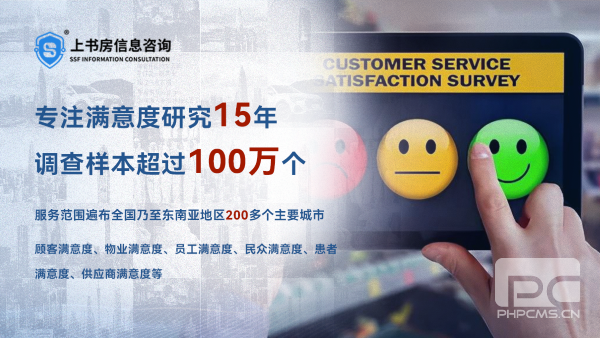湖南市場調研公司開展圖書館客戶滿意度調研
本文由上書房信息咨詢(湖南市場調查公司)出品,歡迎轉載,請注明出處。廣州市場調查第三方評估公司上書房信息咨詢針對不同行業、不同對象進行了研究衍生,包括顧客滿意度、滿意度調研、客戶滿意度調查、物業滿意度、員工滿意度、商戶滿意度、患者滿意度等不同行業、不同類型被訪者進行針對性的研究模型。

開展圖書館客戶滿意度調研的步驟如下:
1、確定調研目標:明確調研的目的和想要了解的內容,例如評估用戶對圖書館服務、設施、資源等方面的滿意度,或者了解用戶需求和期望。
2、設計調研問卷:根據調研目標,設計一份符合需求的調研問卷。問卷應包括相關的主題和問題,覆蓋調研內容的各個方面,并提供多種回答選項,以及開放性問題以收集用戶的意見和建議。
3、確定調研樣本:確定參與調研的樣本群體,可以是圖書館的各類用戶,如學生、教師、研究人員、社區居民等。確保樣本能夠代表整體用戶群體,并在樣本選擇上采用隨機抽樣或者其他合適的方法。
4、進行調研數據收集:通過在線調查、紙質問卷、面訪等方式,向選定的樣本群體發放調研問卷,并收集他們的回答和意見。確保調研過程中的數據收集和信息保密。
5、數據分析和結果呈現:對收集到的數據進行統計和分析,利用合適的數據分析工具和方法,生成相關的統計報告、圖表或可視化結果。根據調研結果,總結關鍵發現和結論。
6、結果解讀和改進措施:根據調研結果,分析用戶的反饋和需求,識別圖書館的優勢和不足之處,并制定相應的改進措施。這些改進措施可以包括提升服務質量、增加資源種類、改進設施、加強培訓等方面。
7、反饋和溝通:向參與調研的用戶提供調研結果的反饋,展示改進計劃和措施。與用戶建立溝通渠道,回應用戶的關切和意見。
8、持續改進:圖書館應將滿意度調研作為一個持續改進的過程,定期進行調研,跟蹤用戶滿意度的變化,及時調整和改進服務策略。
以上是圖書館客戶滿意度調研的一般步驟,具體的實施可以根據圖書館的特點和需求進行調整和定制。
消費者滿意度研究公司上書房信息咨詢在2022年服務客戶超過100家,包含了寫字樓、產業園區、住宅、上海第三方滿意度測評、景區滿意度調查、滿意度調查問卷、深圳公眾民意調研、客戶滿意度調查、廣州醫院滿意度測評、開展購物滿意度調查、開展購物市場調查、滿意度調查報告、第三方評估市場調查、第三方評估市場調研、第三方評估市場調研機構、成都市場調查、上海小區業主滿意度調查等多種類型,調查項目覆蓋了國內160余個城市,通過電話調查、網絡問卷、現場訪問、深度訪談、焦點小組等方式調研有效樣本超5,000,000個。
How to Conduct Customer Satisfaction Survey in Libraries
Here are the steps to conduct a library customer satisfaction survey:
1、Determine the research objectives: Clearly define the purpose of the survey and the specific areas you want to assess, such as evaluating user satisfaction with library services, facilities, resources, etc., or understanding user needs and expectations.
2、Design the survey questionnaire: Based on the research objectives, design a survey questionnaire that addresses the desired topics and questions. The questionnaire should cover various aspects of the research content and provide multiple response options, as well as open-ended questions to gather users' opinions and suggestions.
3、Identify the survey sample: Determine the sample group to participate in the survey, which can include various types of library users, such as students, faculty, researchers, community residents, etc. Ensure that the sample represents the overall user population and use random sampling or other appropriate methods for sample selection.
4、Collect survey data: Distribute the survey questionnaire to the selected sample group through online surveys, paper questionnaires, face-to-face interviews, etc., and collect their responses and feedback. Ensure data collection during the survey process is conducted securely and confidentially.
5、Analyze data and present results: Perform statistical analysis on the collected data using suitable data analysis tools and methods. Generate relevant statistical reports, charts, or visualizations based on the survey results. Summarize key findings and conclusions from the research.
6、Interpret results and identify improvement measures: Analyze user feedback and needs based on the survey results. Identify the strengths and areas for improvement in the library's services and facilities, and develop corresponding improvement measures. These measures may include enhancing service quality, expanding resource offerings, improving facilities, strengthening training programs, etc.
7、Provide feedback and communication: Provide feedback on the survey results to the participating users, showcasing improvement plans and measures. Establish communication channels with users to address their concerns and feedback.
8、Continuous improvement: Treat the customer satisfaction survey as an ongoing improvement process. Conduct regular surveys to track changes in user satisfaction and adjust and improve service strategies accordingly.
These are general steps for conducting a library customer satisfaction survey. The implementation can be customized and adjusted based on the specific characteristics and needs of the library.





